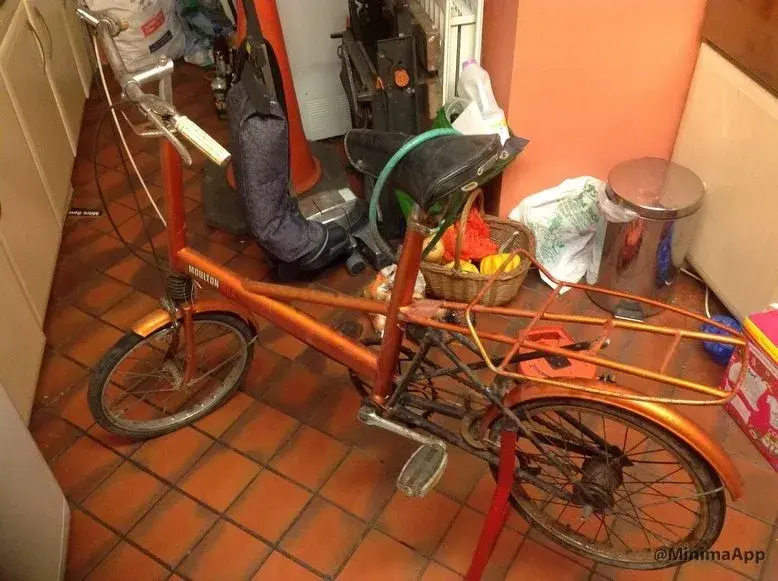Looks to me like you're trying to fit a calliper brake to the rear triangle of a Moulton Mk3. You've set yourself up for few complications...
The Mk3 was not originally fitted with a calliper brake. It had a Sturmey Archer S3B rear hub as OEM. This was a Sturmey Archer AW 3-speed hub combined with a cable-operated drum brake. The drum brake was very poor when new and became considerably worse with use, due to the inadequate seal between the geared part and the drum brake part allowing oil from the epicyclic gears to leak onto the drum brake shoes. Not one of Sturmey's finest offerings.
The rear triangle of a Mk3 has shaped plates welded to both the chainstays and seatstays which look like they are for fitting calliper brakes. They even have the correct size holes drilled in them. However, these plates are made of thin sheet metal and were only originally meant for attaching mudguards. You can fit brake callipers to them but the plate will flex alarmingly under heavy braking with a well-designed calliper. The callipers also need to be very long reach to make the distance to the 16 x 1 3/8 (37 - 349) rims. Neither of these facts is conducive to having a reassuringly good rear brake.
Having spelled out the doom and gloom, are there any solutions? Well, the original chromed-steel Phillips brake callipers as fitted to the rest of the F-frame Moulton range work very well, even if they are a bit heavy and perhaps rather unglamorous. They also have the necessary reach and are stiff enough, being made from steel. Add in decent modern brake pads and they're pretty good. I haven't yet found a period alloy calliper that will reach to 16" rims and is substantial enough to give good braking. Modern Alhonga/Tektro deep-drop dual-pivot alloy callipers work very well and might just reach far enough but I can't confirm - I use these on my Mk3 but I have 17" wheels (32 - 369) fitted which are a little larger.
One further point to remember is that the brake cable to the rear calliper is very long and also follows a fairly tortuous route. This really doesn't help the braking action either. So, all things considered, don't expect to obtain brilliant braking from a rear calliper bake on a Mk3.
The Mk3 was not originally fitted with a calliper brake. It had a Sturmey Archer S3B rear hub as OEM. This was a Sturmey Archer AW 3-speed hub combined with a cable-operated drum brake. The drum brake was very poor when new and became considerably worse with use, due to the inadequate seal between the geared part and the drum brake part allowing oil from the epicyclic gears to leak onto the drum brake shoes. Not one of Sturmey's finest offerings.
The rear triangle of a Mk3 has shaped plates welded to both the chainstays and seatstays which look like they are for fitting calliper brakes. They even have the correct size holes drilled in them. However, these plates are made of thin sheet metal and were only originally meant for attaching mudguards. You can fit brake callipers to them but the plate will flex alarmingly under heavy braking with a well-designed calliper. The callipers also need to be very long reach to make the distance to the 16 x 1 3/8 (37 - 349) rims. Neither of these facts is conducive to having a reassuringly good rear brake.
Having spelled out the doom and gloom, are there any solutions? Well, the original chromed-steel Phillips brake callipers as fitted to the rest of the F-frame Moulton range work very well, even if they are a bit heavy and perhaps rather unglamorous. They also have the necessary reach and are stiff enough, being made from steel. Add in decent modern brake pads and they're pretty good. I haven't yet found a period alloy calliper that will reach to 16" rims and is substantial enough to give good braking. Modern Alhonga/Tektro deep-drop dual-pivot alloy callipers work very well and might just reach far enough but I can't confirm - I use these on my Mk3 but I have 17" wheels (32 - 369) fitted which are a little larger.
One further point to remember is that the brake cable to the rear calliper is very long and also follows a fairly tortuous route. This really doesn't help the braking action either. So, all things considered, don't expect to obtain brilliant braking from a rear calliper bake on a Mk3.
